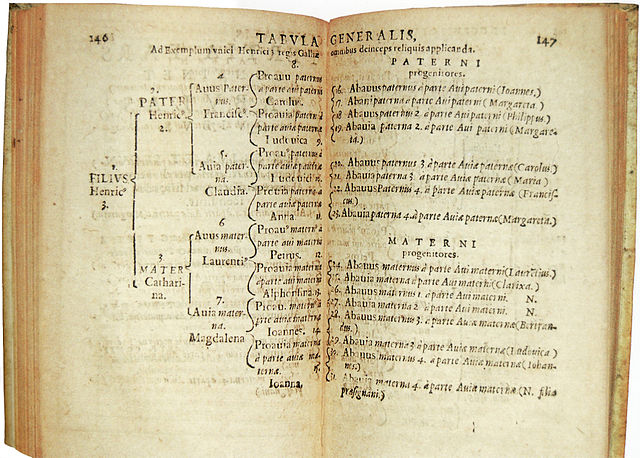An ahnentafel or ahnenreihe is a genealogical numbering system for listing a person's direct ancestors in a fixed sequence of ascent. The subject of the ahnentafel is listed as No. 1, the subject's father as No. 2 and the mother as No. 3, the paternal grandparents as No. 4 and No. 5 and the maternal grandparents as No. 6 and No. 7, and so on, back through the generations. Apart from No. 1, who can be male or female, all even-numbered persons are male, and all odd-numbered persons are female. In this schema, the number of any person's father is double the person's number, and a person's mother is double the person's number plus one. Using this definition of numeration, one can derive some basic information about individuals who are listed without additional research.

The first ahnentafel, published by Michaël Eytzinger in Thesaurus principum hac aetate in Europa viventium Cologne: 1590, pp. 146–147, in which Eytzinger first illustrates his new functional theory of numeration of ancestors; this schema showing Henry III of France as n° 1, de cujus, with his ancestors in five generations. The remainder of the volume shows 34 additional schemas for rulers and princes of Europe using his new method.
Seize quartiers coat of arms display document (1786)
Ahnentafel of Sigmund Christoph von Waldburg-Zeil-Trauchburg
Ahnentafel published as an Ariernachweis
Genealogical numbering systems
Several genealogical numbering systems have been widely adopted for presenting family trees and pedigree charts in text format.
The first Ahnentafel, published by Michaël Eytzinger in Thesaurus principum hac aetate in Europa viventium Cologne: 1590, pp. 146-147, in which Eytzinger first illustrates his new functional theory of numeration of ancestors; this schema showing Henry III of France as n° 1, de cujus, with his ancestors in five generations.




